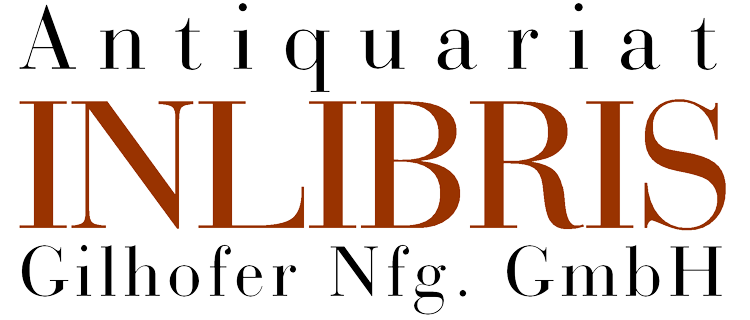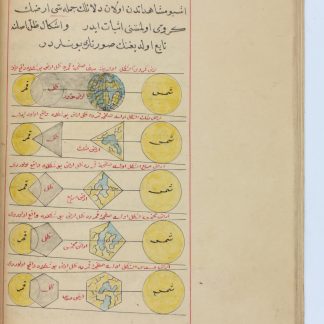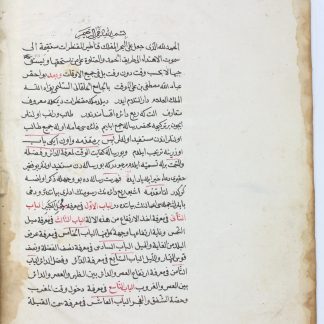Ottoman astrological manuscript
[Book on Astrology and Zodiac Signs].
8vo (120 x 170 mm). (52) pp., 2 blank ff., (5), 48, (2), (2 blank), (80) pp. Ottoman manuscript on paper. Black and red ink on polished paper. With numerous full-page colour diagrams (both in coloured ink and coloured pencil), one including a sketch of the Kaaba in Mekka, and an inserted volvelle on cardboard. Bound in boards (ca. 1900) covered with waste paper printed in Ottoman Turkish, Armenian, Greek, and French.
$3,908.00
An exceptional Ottoman manuscript on astrology and divination, consisting of practical booklets, information, and calendars that would help the reader navigate daily life with the knowledge of the celestial movements. Not dated; however, one of the calendars starts with 1222 Rumi (= 1807 CE), and the Chinese Animal Years start with 1218 Rumi (= 1804 CE), indicating the manuscript was compiled in the early 19th century.
A substantial portion of the manuscript consist of booklets and diagrams on the moon and lunar mansions, a part of Islamic astrology known as "Manazil al-Qamar" (Mansions of the Moon). The first part, entitled "Serh-i Menazilü'l Kamer" (Commentary on Lunar Stations), is a guide to daily life based on the manzil (house) of the moon in various signs of the zodiac (for example, on days on which the moon is stationed at the Aquarius sign, one may make new friends, talk with scholars, or plant seeds, but should abstain from travelling or trading). Two shorter texts and three diagrams on the same topic span the first half. The manuscript also includes two examples of a 'gurre nameh', a type of tabular moon calendar used to calculate the first day of the lunar month.
The compiler of this manuscript was not only interested in the lunar mansions, but also in other types of astrological predictions. An interesting table records in detail the meaning of certain phenomena such as earthquakes, a red sky or eclipse when they occur on the day of a certain sign of the zodiac. Another interesting section is on the Chinese zodiac, which was also used by Turks with changes in some animal names, such as crocodile instead of dragon or lion instead of tiger.
An obsession with the days of the week is apparent in three sections. Two are devoted to the prediction of the coming year, based on which day of the week the first day of the month Muharram, the first month of Hijri calendar, or Nowruz, the first day of spring, falls on. Another is simply on the significance of the days (what is auspicious to do on certain days and what is inadvisable), including predictions made for a person based on the day they were born. For instance, Cain apparently killed Abel on a Tuesday and God created deception, thus Tuesday is not considered an auspicious day to start a project.
This extensive compendium includes two meticulously prepared calendars: the first, a monthly one which starts with March (the first month in Ottoman Rumi calendar), noting important events (such as the Flood of Noah) or agricultural dates. The second one is yearly, spanning the years 1222-93 Rumi (1807-78 CE); this calendar provides guidance on what to do and to avoid on certain days, records various celestial phenomena such as changes in stars, and calculates the times of sunrise and sunset.
The final eight leaves contain an almost feverish combination of brief texts on the interpretation of dreams based on the first letter of the dream; what the sensation of twitching in various organs means; the use of hoopoe birds; and, lastly, the rules of bloodletting.
Signs of damp- and waterstaining; a few leaves damaged or illegible. Binding noticeably stained; modern spine.


















